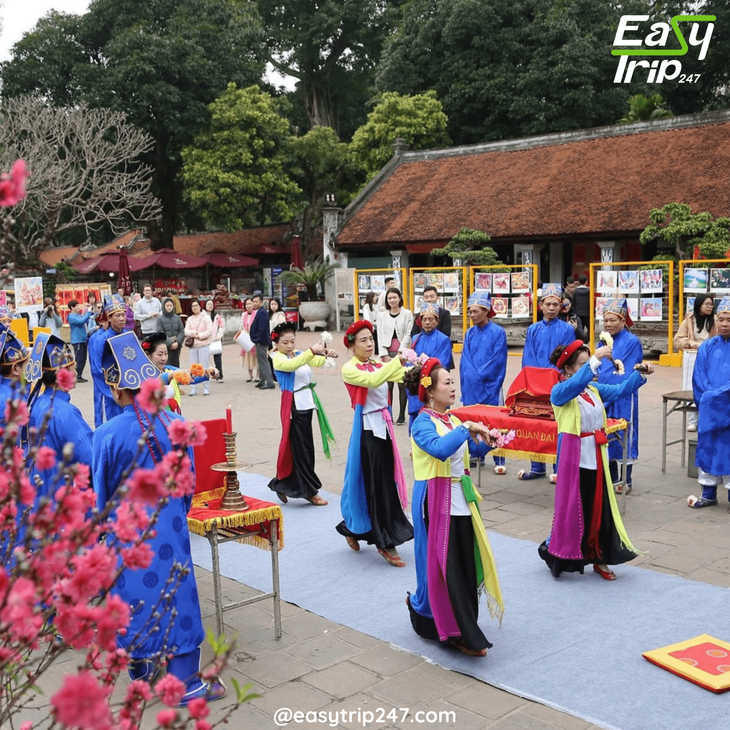Traditional Ceremonies at the Temple of Literature: What to Know
On
23/06/2025Reading time:
1 min
Summary:
The Temple of Literature Hanoi is more than just an architectural treasure or a relic of the past—it's a living symbol of Vietnam's enduring reverence for education, scholarship, and Confucian ideals.

When you step into the Temple of Literature Hanoi, you’re entering a world where tradition still breathes. Built in 1070 and dedicated to Confucius, the temple later became Vietnam’s first national university. While the stone stelae and ancient pavilions stand as silent witnesses to centuries of academic pursuit, it's the traditional ceremonies that truly animate the spiritual heart of this place. Understanding and experiencing these rituals offers a deeper appreciation for Vietnam’s cultural identity and its profound respect for learning.
One of the most prominent traditional ceremonies held at the Temple of Literature Hanoi is the Bái Tổ ritual. This homage to Confucius and ancient scholars is conducted to invoke blessings of wisdom, good fortune, and intellectual success. Held several times a year—especially before major exams—students and their families gather in the temple, lighting incense and offering symbolic gifts such as fruit, tea, and calligraphy scrolls. The atmosphere is thick with hope, devotion, and gratitude, as generations seek favor from the deities of knowledge.
Another remarkable event that defines the spiritual life of the Temple of Literature Hanoi is the Tet Calligraphy Festival. Every Lunar New Year, the temple's courtyards become alive with the flowing brushstrokes of master calligraphers. Visitors line up to receive hand-written words like “Prosperity,” “Wisdom,” and “Peace” on red paper, which are then taken home and displayed for blessings in the coming year. This fusion of art, tradition, and education underscores the temple’s enduring role as a beacon of Vietnamese values.
A particularly moving moment at the Temple of Literature Hanoi occurs during the annual graduation season. Young scholars dressed in traditional ao dai flock to the temple grounds to take photos, pay their respects, and thank their ancestors for educational opportunities. Often, students bring small offerings or light incense at the altars in quiet reflection. For many, this pilgrimage is both a personal and communal rite of passage—marking the end of one journey and the hopeful beginning of another. The temple becomes a bridge connecting youth to their roots and to the timeless pursuit of knowledge.
The Temple of Literature Hanoi is also a focal point during Vietnamese Teachers' Day on November 20th. As a society that holds educators in the highest esteem, this day sees thousands visiting the temple to honor not just ancient scholars but also their own teachers. Offering flowers, writing thank-you notes, and participating in commemorative events, visitors transform the temple into a living tribute to education. Such moments reinforce the temple’s role not just as a historical site, but as a cultural compass guiding respect for learning and mentorship.
Beyond public celebrations, many smaller, lesser-known traditional ceremonies take place throughout the year at the Temple of Literature Hanoi. These include ceremonial processions, ancestral worship rites, and Confucian music performances that pay homage to Vietnam’s scholarly traditions. These more intimate events often attract local scholars, historians, and cultural preservationists who work diligently to ensure that Vietnam's intangible heritage is not lost to time. Visitors lucky enough to witness these ceremonies gain a rare insight into a Vietnam that values quiet reflection as much as vibrant expression.
An integral part of these ceremonies is the traditional attire worn by participants. Robes and headdresses in rich hues of red, gold, and blue reflect ancient Confucian symbolism. The flowing garments, paired with solemn music played on traditional instruments like the dan bau or dan tranh, create a sensory experience that transports you to another era. The reverent silence punctuated by gong strikes or the rhythmic chant of ancient texts creates a spiritual resonance that stays with you long after leaving the Temple of Literature Hanoi.
Even for international visitors, these ceremonies at the Temple of Literature Hanoi are accessible and inviting. Information plaques, audio guides, and guided tours in multiple languages ensure that tourists can grasp the significance of what they’re witnessing. What’s more, visitors are encouraged to participate respectfully—whether by writing their wishes during Tet, purchasing a calligraphy artwork, or lighting a stick of incense in quiet reverence. In these shared experiences, cultural barriers fade, replaced by a universal respect for wisdom and tradition.
The Temple of Literature Hanoi also plays host to state and diplomatic ceremonies, symbolizing the temple's national importance. Foreign dignitaries are often brought to the temple as part of official tours, showcasing Vietnam’s pride in its intellectual and cultural roots. This blend of national pride and ceremonial elegance has positioned the temple not only as a historic treasure but also as a soft power symbol of Vietnamese heritage.
In recent years, efforts to preserve and revitalize the traditional ceremonies at the Temple of Literature Hanoi have gained momentum. Local authorities, in collaboration with cultural organizations, have launched programs to educate the younger generation about these rituals. Schools partner with the temple to hold mock ceremonies for students, ensuring that future generations carry forward the legacy of respect, knowledge, and harmony that the temple represents.
The traditional ceremonies at the Temple of Literature Hanoi do more than preserve the past—they nourish the present and inspire the future. In a rapidly modernizing world, they serve as a grounding force, reminding both locals and visitors of values that withstand the test of time: reverence for learning, respect for the past, and hope for a brighter tomorrow. Whether you're a student, traveler, historian, or simply someone seeking a moment of peace, the temple welcomes you into its sacred fold with rituals that speak to the soul.
So if your journey brings you to Hanoi, set aside time to explore the Temple of Literature Hanoi—not just as a tourist attraction, but as a living, breathing sanctuary of culture. Time your visit with one of its traditional ceremonies, and you’ll leave not only with beautiful memories but with a deeper understanding of Vietnam’s heart.
Design Your Tour Today And Get A Quote. Contact Us Here: +84.975.504.825
Source: Easytrip247 Team compiled.
